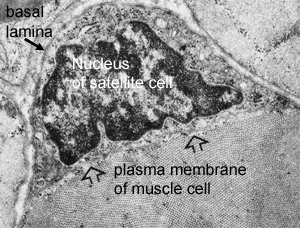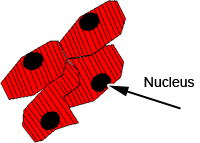Muscle: Muscle regeneration

Skeletal muscle contains numerous 'satellite cells' underneath
the basal lamina, as shown in the photograph opposite. These are
mononucleated quiescent cells. When the muscle is damaged, these
cells are stimulated to divide. After dividing, the cells fuse with
existing muscle fibres, to regenerate and repair the damaged fibres.
The skeletal muscle fibres themselves, cannot divide. However,
muscle fibres can lay down new protein and enlarge (hypertrophy).

Cardiac muscle can also hypertrophy. However,
there are no equivalent to cells to the satellite cells found in skeletal
muscle. Thus when cardiac muscle cells die, they are not replaced.

Smooth cells have the greatest capacity to regenerate of
all the muscle cell types. The smooth muscle cells themselves retain
the ability to divide, and can increase in number this way.
As well as this, new cells can be produced by the division of cells
called pericytes that lie
along some small blood vessels.
Smooth muscle can also hypertrophy.

